-
Product Name
SMARCB1 Polyclonal Antibody
- Documents
-
Description
Polyclonal antibody to SMARCB1
-
Tested applications
WB, IHC
-
Species reactivity
Human, Mouse, Rat
-
Alternative names
SMARCB1 antibody; BAF47 antibody; CSS3 antibody; INI1 antibody; MRD15 antibody; PPP1R144 antibody; RDT antibody; RTPS1 antibody; SNF5 antibody; SNF5L1 antibody; SWNTS1 antibody; Sfh1p antibody; Snr1 antibody; hSNFS antibody; SWI/SNF-related matrix-associated actin-dependent regulator of chromatin subfamily B member 1 antibody
-
Isotype
Rabbit IgG
-
Preparation
Antigen: Recombinant fusion protein containing a sequence corresponding to amino acids 77-376 of human SMARCB1 (NP_001007469.1).
-
Clonality
Polyclonal
-
Formulation
PBS with 0.02% sodium azide, 50% glycerol, pH7.3.
-
Storage instructions
Store at -20℃. Avoid freeze / thaw cycles.
-
Applications
WB 1:500 - 1:2000
IHC 1:50 - 1:200 -
Validations
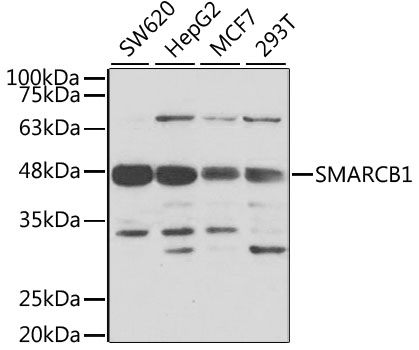
Western blot - SMARCB1 Polyclonal Antibody
Western blot analysis of extracts of various cell lines, using SMARCB1 antibody at 1:1000 dilution.Secondary antibody: HRP Goat Anti-Rabbit IgG (H+L) at 1:10000 dilution.Lysates/proteins: 25ug per lane.Blocking buffer: 3% nonfat dry milk in TBST.Detection: ECL Basic Kit .Exposure time: 5s.
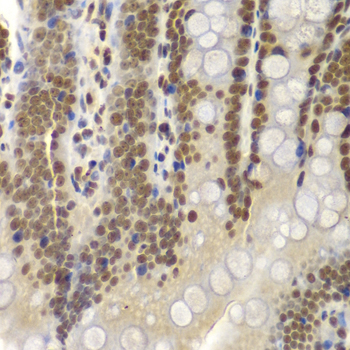
Immunohistochemistry - SMARCB1 Polyclonal Antibody
Immunohistochemistry of paraffin-embedded rat Intestine using SMARCB1 antibody at dilution of 1:200 (40x lens).
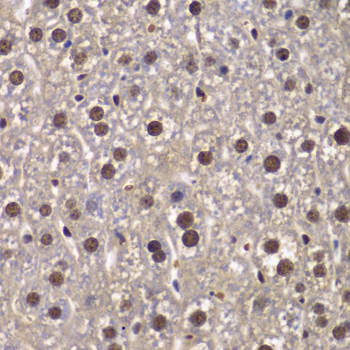
Immunohistochemistry - SMARCB1 Polyclonal Antibody
Immunohistochemistry of paraffin-embedded mouse liver using SMARCB1 antibody at dilution of 1:200 (40x lens).
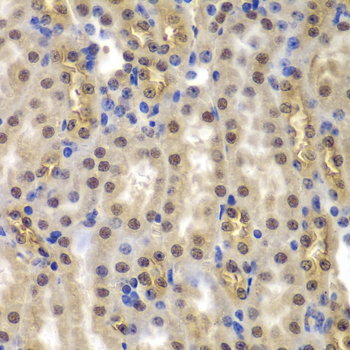
Immunohistochemistry - SMARCB1 Polyclonal Antibody
Immunohistochemistry of paraffin-embedded mouse kidney using SMARCB1 antibody at dilution of 1:200 (40x lens).
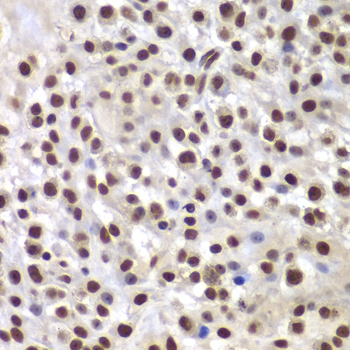
Immunohistochemistry - SMARCB1 Polyclonal Antibody
Immunohistochemistry of paraffin-embedded mouse osteosarcoma using SMARCB1 antibody at dilution of 1:200 (40x lens).
-
Background
Core component of the BAF (hSWI/SNF) complex. This ATP-dependent chromatin-remodeling complex plays important roles in cell proliferation and differentiation, in cellular antiviral activities and inhibition of tumor formation. The BAF complex is able to create a stable, altered form of chromatin that constrains fewer negative supercoils than normal. This change in supercoiling would be due to the conversion of up to one-half of the nucleosomes on polynucleosomal arrays into asymmetric structures, termed altosomes, each composed of 2 histones octamers. Stimulates in vitro the remodeling activity of SMARCA4/BRG1/BAF190A. Involved in activation of CSF1 promoter. Belongs to the neural progenitors-specific chromatin remodeling complex (npBAF complex) and the neuron-specific chromatin remodeling complex (nBAF complex). During neural development a switch from a stem/progenitor to a postmitotic chromatin remodeling mechanism occurs as neurons exit the cell cycle and become committed to their adult state. The transition from proliferating neural stem/progenitor cells to postmitotic neurons requires a switch in subunit composition of the npBAF and nBAF complexes. As neural progenitors exit mitosis and differentiate into neurons, npBAF complexes which contain ACTL6A/BAF53A and PHF10/BAF45A, are exchanged for homologous alternative ACTL6B/BAF53B and DPF1/BAF45B or DPF3/BAF45C subunits in neuron-specific complexes (nBAF). The npBAF complex is essential for the self-renewal/proliferative capacity of the multipotent neural stem cells. The nBAF complex along with CREST plays a role regulating the activity of genes essential for dendrite growth (By similarity). Plays a key role in cell-cycle control and causes cell cycle arrest in G0/G1.
Related Products / Services
Please note: All products are "FOR RESEARCH USE ONLY AND ARE NOT INTENDED FOR DIAGNOSTIC OR THERAPEUTIC USE"
